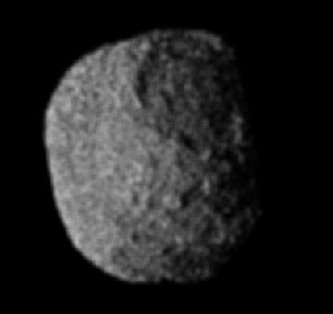It's time once again for this week's Where In The Universe challenge. Take a look at the image above and try to determine where in the universe this image was taken. Give yourself extra points if you can name the spacecraft responsible for taking this image. As always, no peeking below for the before you make your guess.
Here's one more image of this object.
Ready for the answer?
These are images of Neptune's moon Proteus. Needless to say, Proteus is not one of the better-known moons of our solar system. Did you recognize it? Proteus was discovered in 1989 by the only spacecraft that has flown by Neptune, Voyager 2. Though Proteus (400 km diameter) is larger than Neptune's better known moon, Nereid (340 km, which was discovered in 1949 by Gerard Kuiper) Proteus was not discovered earlier because it is very dark and so close to Neptune that it is difficult to see in the glare of the much brighter planet.
Proteus has an irregular almost box-like shape, and scientists believe it is probably about as big as an irregular body can be before its gravity pulls it into a more spherical configuration.
There's not a lot of action on Proteus. The heavily cratered surface shows no signs of geologic activity.
Other than those facts, there's not much to say about Proteus. As Bill Arnett says on his
Nine Planets website,
"We know next to nothing about Proteus." We've not sent a spacecraft to go visit and study Neptune and its moons specifically, and although
NASA was considering sending a probe to Neptune a few years ago
, it appears such a mission has been put on the back burner.
How'd you do in this week's challenge?
 Universe Today
Universe Today
